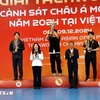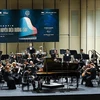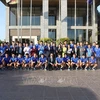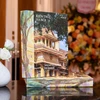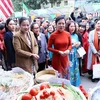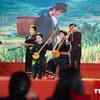Originating from the conception that everything has holy characters, worshipping water god is an early custom popular in water areas in the Red River. An insight of the legend on the gods worshipping in the temples, pagodas in the delta, the festival of water procession, the custom of worshipping these gods can reveal that the vestiges of water worshipping custom is quite strong.
A panorama by the Ministry of Culture, Sports and Tourism web portal.
- Custom of worshipping tutelary god: Legend and original…
Originating from the ancient Chinese time, after integrating into Vietnam, it quickly grasped into the soul of Vietnamese people and has become very diversified. The tutelary god may be a god such as Phu Dong Thien Vuong, a mountain god such as Tan Vien or a god having credits with the country and people such as Ly Thuong Kiet, Tran Hung Dao, Yet Kieu, Da Tuong, etc.
Sometimes bad gods… with many stories which are strange, unreasonable. However, the tutelary gods who have been appointed (with the exception of bad gods) always symbolises the villages that they control which is a reflection of history, morality, customs, law as well as the hope for survival of the whole village. The tutelary god has the power to brighten invisibly like a super power, which may make villages become a tight system.
According to the ancient customs, kings often appoint tutelary gods into three levels: the highest, the middle and the lowest tutelary gods, depending on the stories, and credit of the gods towards the country, people and villages. The gods are considered to put from these positions to the other ones, if during the controlling time, these gods help people much in the spiritual life and physical life of the people. The appointment for tutelary gods should base on the petition to the king of the villages about the credit of the gods. This petition to the king should be submitted to the royal palace per regulated time. In each time for appointment, the royal palace always sent the knight very solemnly and kept it in the knight box being worshipped in the palace of the communal house.
The tutelary god is regarded as the bless god, or the god bringing about conferring blessings to the villagers, it is often the case that each village worships a tutelary god, but sometimes a village worship two or three gods or three villages worship a shared god. The tutelary god can be female or male, depending on the stories of each village.
The communal house is the place worshipping tutelary gods, and has become a holy cultural symbol of each Vietnamese people. Every village has communal house, and each hamlet may has separate communal houses. The communal house worship the tutelary god but at the same time becoming the gathering place of village dignitaries, or the place for activities of the village community. Every activity takes place in the communal house under the witness of the tutelary god.
In the soul of Vietnamese people, the tutelary god is the superpower god, who can witness the whole life of the village, protecting and helping villagers to be prosperous and healthy. The generations of the village grow up and grow up but the tutelary god is forever, and has become the vestige of a village through ups and downs.
It can be said that the tutelary god is the super controller of the village not only in the spiritual life but it is still a part of physical life of the village. So the worshipping of tutelary gods is the worshipping of the rules of villages, and the habits as well as customs of the villages.
This worshipping is the intangible contact to help villagers to unite, the lifestyle of harmonisation, the habits and customs of the villages are protected. Therefore, the authorised people or other families in the village that wish to open festivals or hold any events should have sacrifices to ask for permission first.
- The special holy ritual of the wet rice culture in the border of the Red River
The water procession is a special holy ritual reflecting the belief of praying for water of people living with the wet rice culture by the river, in the worshipping ritual of river god. Almost all procedures and activities in the procession such as dragon dance, fish procession, boat racing, water procession, etc, are related to water – one very important factor in agricultural production. Through this ritual, people would like to pray for timely rains and favorable conditions to grow rice conveniently, to get abundant crops.
* Water procession at the festival commemorating the god Chu Dong Tu
From 10 to 12 February lunar calendar annually, people of Binh Minh, Me So and Da Trach communes in Chau Giang district (Hung Yen province) often hold festivals to commemorate the god Chu Dong Tu.
At Da Hoa temple, i n the early morning of the 10th, inhabitants of nine communes hold a long procession along the dyke of the Red River to Da Hoa temple. Marching in the van of the procession are residents of Hoang Trach commune, followed by their fellows of Dong Que, Bang Nha, Phu Thi, Phuc Trach, Thiet Tru, Nhan Thap, Da Hoa communes, and finally those of Me So commune.
When the procession reaches the temple, palanquins and offerings are placed at a designated place. Then, the members of the procession and pilgrims begin the opening ceremony at the courtyard.
As the opening ceremony and incense presenting ceremony end, people participate in day-long traditional games.
At Da Trach temple, i n the morning of the 10th, residents of Da Trach, Ham Tu, Yen Phu, Dong Tao and Tu Dan communes, Khoai Chau district, Hung Yen province, hold a procession from Da Trach temple to the Red River to get water.
The water procession is preceded by a 20-meter-long dragon. Thirty strong young men carry the dragon and dance in the rhythm of drumbeats, which makes the procession jubilant, followed by two rows of women in colorful dresses holding flags, gongs and drums, and parasols. Young women perform a dance with conical hats and castanets with coins stringed. Young men carry palanquins holding a jar, and a profusely decorated stick and conic hat - the two magic articles bestowed on Chu Dong Tu by the Buddha. Then come three palanquins containing the tablets of Chu Dong Tu and his two wives. The end is God of Carp palanquin "Be ngu than quan". Notable men in traditional costumes go after the procession.
When the procession arrives at the riverbank, the boats of Khoai Chau district sail downstream the Red River to meet the procession of Mai Dong commune (Hung Yen province), Khai Thai and Tu Nhien communes (former Ha Tay province, now Hanoi). They join into a long procession and row to middle of the river to get water. The procession brings water to the temple at 11.30 a.m and the opening ceremony begins.
After the water palanquin is placed in the temple, palanquins of gods are placed in the courtyard, then the dragon dancing group comes to the temple's door worship god; senh tien dance and conical hats dance are performed on Tien bridge. After the opening ceremony, various games and activities are organised such as wrestling, human chess, and traditional and religious dances.
* Water procession of traditional festival of Hoa Lu ancient capital
The traditional festival of Hoa Lu ancient capital (in the past called Truong Yen festival, Co Lau festival) often takes place from March 8-10 of the lunar calendar annually. This is a chance to commemorate two kings, national heroes : Dinh Tien Hoang and Le Dai Hanh.
The festival has existed since Hoa Lu capital became an ancient one. The festival has the largest scale in years with the end numbers are three, five, eight and zero.
The ceremony begins with a water procession, the greeting group starts from Dinh Tien Hoang’s temple and move towards Hoang Long river. The preparation for the procession is quite elaborate. The day before the opening ceremony, local people choose a big bamboo on the banks of Hoang Long river and tie a yellow silk band with the best wishes written on it to the top of the bamboo. When the group reach the river, they get on dragon boats and row to the middle of the river. They start to throw votives down to the river to show respect to Ha Ba (river god) and hope for a good luck and peaceful year. Afterwards, the host of the ceremony throws a cloth circle onto the river and then take water from it to pour into a jar covered with red cloth. This jar is brought back to the temple.
Right after coming back to temples to Dinh King and Le King, the group carry out a worshipping ceremony. To begin with, the host makes a worshipping speech, which is divided into nine paragraphs. After each paragraphs is finished, a man and a woman will sing a Ca tru tune in order to explain what the host has just said.
Besides ceremony, visitors can enjoy interesting entertainment programs and take part in many fun traditional games such as human chess, martial art, boat racing, singing Chau van, making poems, writing Han ideograph. The most exciting game is Co lau tap tran (reed drill) which recounts the childhood of Dinh Bo Linh.
* Water procession in Giong festival
The festival is an event which implements many compulsory rituals. This ritual is carried out in tight and strict order from preparing to the end of the festival. Frequently, a festival often has rituals: ceremony of clean statue, sacrifice, procession, opening ceremony of the festival and the closing ceremony of the festival.
Ceremony of cleaning statue (bathing ceremony for god statue): This ceremony is usually carried out at midnight before the date of opening ceramony.
* Water procession in Ngu Doi temple festival
Ngu Doi temple is located Duy Binh hamlet, Vinh Ninh commune, Vinh Tuong district. Annually, the festival of Ngu Doi temple takes place within the 14th and 15th days of the lunar February. The festival is attached to the beliefs worshipping Tan Vien god, one of “four immortals” of Vietnam, which is regarded as the ancestor of farming in the Red River delta in Doai (west) region – the area belonging to Son Tay border gate in the old time.-VNA












